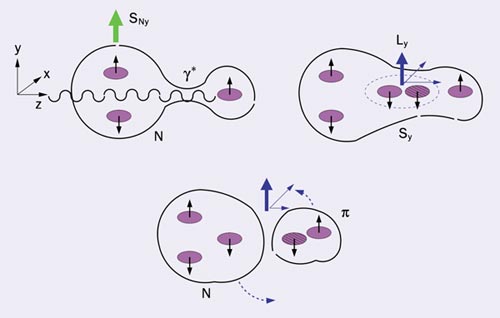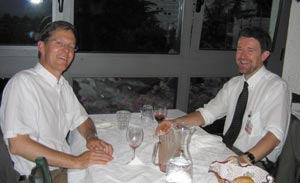A recent workshop on new developments in nucleon spin structure, held at the ECT* in Trento, revived memories of the famous Council of Trento of 1530.

During physics workshops experts generally get together to present the outcome of recent work, confront and discuss new ideas, gain inspiration for further work, and incidentally start new collaborations. Sometimes, however, the conditions are so favourable that all workshop activities seem to be oriented towards a unique common goal. Each participant feels like a member of one team co-operating to accomplish a well defined goal. This is just what happened during the international workshop on “Transversity: New Developments in Nucleon Spin Structure” in June 2004, which brought together some 40 leading experimental and theoretical physicists in the field of nucleon spin structure at the European Centre for Theoretical Physics (ECT*) in Trento, Italy.
Many interesting talks were presented by renowned experts, supplemented by shorter, but no less inspiring, talks by PhD students and postdocs. The talks illustrated and substantiated the rapid developments in the new field of transverse spin physics. Indeed, the results presented were so encouraging that the idea emerged spontaneously to devote part of the scheduled (and unscheduled) discussion time to the preparation of a document, soon christened The Trento Convention, which would contain all relevant notations and conventions that are crucial for the achievement of further progress in this field. The document, which is now well under way, will soon be submitted to the e-print archives. While it has been set up by a few representatives (A Bacchetta, U D’Alesio, M Diehl and A Miller), it is in a sense co-authored by all the workshop participants. Just like the famous First Vatican Council that took place in Trento almost 500 years ago in 1530, the document represents a common frame and a common language for an unambiguous comparison between theory and experiment. It will be an indispensable tool to boost further developments in this field.
Why is such a seemingly technical subject as transverse spin physics so fascinating? From recent cosmological observations, for instance by the WMAP satellite, we know that visible matter represents only 4% of the universe. Of this small percentage only a minute fraction can be attributed to the mass of the quarks, for which – most likely – the Higgs mechanism has to be invoked. The remaining, and by far the largest, part of the mass of the visible universe has a dynamical origin. It is the dynamics of the quarks and gluons in the nucleon, as governed by the theory of strong interactions – quantum chromodynamics (QCD) – that needs to be fully understood to be able to account for the mass of the nucleon and hence that of the visible universe. It is this quest that drives theorists and experimentalists alike to study the transverse spin structure of the nucleon, giving access to subjects such as the orbital motion of quarks – a crucial ingredient of parton dynamics.
In the famous EMC (European Muon Collaboration) experiment at CERN, it became evident in 1988 that only a small fraction of the proton spin is carried by the helicities of the valence quarks. Since then much work has been done in unravelling the origin of the proton’s spin, in particular identifying the carriers of nucleon angular momentum in the framework of QCD. Thanks to a tremendous effort in both experiment and theory, we now know how to encode information on the dynamics of polarized quarks and gluons into a formalism that can be rigorously derived from QCD. This effort has also led to the definition of new observables and the introduction of methods to measure new effects associated with these observables. Transverse spin is an example of such a new observable, and it has generated considerable interest as it enables the study of the spin structure of the nucleon while “switching off the gluon contribution”. Moreover, the first observation of transverse spin effects in experiments – as presented at the workshop – gives indirect evidence for the existence of quarks with non-zero orbital angular momentum in the nucleon.

Only slightly more than a decade ago it was realized by Robert Jaffe of MIT among others that there is a third leading-order quark distribution function apart from the well known structure function F2 and the spin-dependent distribution function g1. This distribution of transversely polarized quarks in a transversely polarized nucleon, also known as “transversity”, is nowadays acknowledged as a crucial ingredient of the spin structure of the nucleon. However, until less than a year ago no data on this distribution function existed. On the other hand, measurements of transverse spin distributions would not only enable the study of the issues mentioned above (on spin effects without gluons and orbital motion), but would also make it possible to verify QCD predictions on the deformation of this quark distribution in polarized nucleons (known as the nucleon tensor charge) and the novel QCD evolution properties of this distribution function. Unfortunately, transversity is experimentally very difficult to access because it involves a simultaneous flip of the helicity of both the struck quark and the target; it is, to use some jargon, a “chiral-odd” object. For that reason another chiral-odd object is needed to arrive at a measurable (i.e. chiral even) cross-section. This can be realized in polarized Drell-Yan (p↑p↑ → l+l– X) or semi-inclusive processes with hadron beams (pp↑ → πX) or lepton beams (lp↑ → l´πX).
In semi-inclusive processes, experimentally an azimuthal asymmetry is searched for in the produced π mesons. Such an azimuthal asymmetry – i.e. with pions preferentially produced in one hemisphere rather than the other with respect to the scattering plane – may arise for two reasons. Assuming a string breaking mechanism, a quark-antiquark pair with a non-zero internal angular momentum is produced (see figure 1) and/or the struck quark already had some intrinsic orbital angular momentum. These mechanisms are known as the Collins and Sivers effects, respectively. For years it was commonly believed that they had to be suppressed because they violate invariance under the time-reversal transformation. However, as was shown by Stanley Brodsky of SLAC and Dae Sung Hwang of Sejong University in Seoul (the latter being present at the workshop), a residual interaction with the jet remnants enters the description of these reaction processes and prevents the time-reversal argument from being applicable. The proper description of this additional interaction was addressed by several speakers at the workshop, including Andreas Metz of Bochum and Dennis Sivers of Portland, indicating that there exists a possible link to chiral-symmetry breaking effects in QCD.

The first data on azimuthal asymmetries observed in deep-inelastic lepton scattering on transversely polarized proton targets were presented at the workshop by Andy Miller for the HERMES experiment at DESY (figure 2) and Rainer Joosten for COMPASS at CERN. These data represent only the beginning of a whole new generation of experiments that enable measurements of single-spin asymmetries as small as a few percent, while they are differential in two to three kinematical variables. Other collaborations, such as STAR and PHENIX at the Relativistic Heavy Ion Collider at Brookhaven and CLAS at the Thomas Jefferson Laboratory, presented other asymmetry measurements that give information on related processes. Moreover, the HERMES collaboration showed first results for the azimuthal asymmetry related to the Sivers mechanism, which – the data being non-zero – provided direct evidence of the existence of quark orbital angular momentum.
On the theoretical side much progress has been obtained in studying the universality of the transverse-momentum-dependent parton distribution and fragmentation functions. Both John Collins and Andreas Metz argued that this universality, or process independence, is now almost completely established for deep-inelastic scattering, e+e– annihilation and the Drell-Yan process, although it is still under debate for proton-proton annihilation because of the complicated field-theoretical structure of the diagrams involved. In parallel, an increasing number of groups – including Leonard Gamberg at Pennsylvania State University, Umberto d’Alesio from Cagliari, Aram Kotzinian of CERN and others – are calculating these functions either within models or by means of lattice QCD simulations, as discussed by Philip Haegler of Regensberg, in order to interpret both new and existing data. At the workshop it became clear that, despite the large amount of work already done and in progress, it is still too early to draw definite conclusions. Many speakers insisted that a new global analysis of all direct and indirect measurements is needed to make further progress. For that reason the development of The Trento Convention is very timely.

This is a rapidly changing field, and new experimental and theoretical avenues are currently being explored. The former, presented by Delia Hasch of Frascati, include azimuthal asymmetries with inclusive detection of two pions, upgrades of existing experiments and the use of polarized antiproton beams and targets to extract transversity from Drell-Yan measurements at the future HESR ring at GSI (which was presented by Frank Rathmann). New theoretical avenues include the first exploratory calculations of chiral-odd objects on the lattice, and the study of the relationship and complementarity between transverse-momentum-dependent (chiral-odd) parton distributions and the (chiral-odd) generalized parton distributions, which give a picture of the transverse distribution of partons in three-dimensional space, as described by Markus Diehl of DESY and Matthias Burkhart of New Mexico State/ECT*.
Although only a first small sample of data on azimuthal asymmetries with transversely polarized targets is as yet available, the field is already confronted with rapid experimental and theoretical developments giving new insights into the QCD structure of the nucleon in general and the role of orbital angular momentum and transverse spin in particular. In Trento this gave rise to an outspoken enthusiasm, illustrated by the many lively discussions. All of this reflects the enormous activity in this relatively new branch of QCD physics.
Further reading
HERMES collaboration 2004 http://arxiv.org/abs/hep-ex/0408013.








